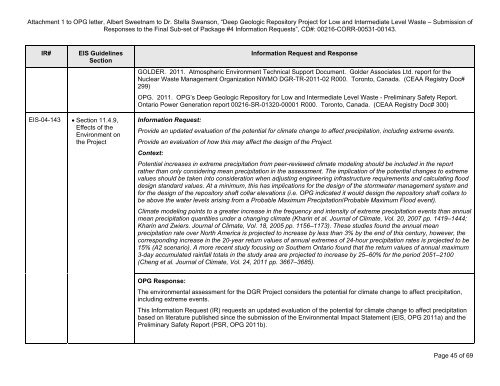Ontario Power Generation's Response to the Joint Review
Ontario Power Generation's Response to the Joint Review
Ontario Power Generation's Response to the Joint Review
Create successful ePaper yourself
Turn your PDF publications into a flip-book with our unique Google optimized e-Paper software.
Attachment 1 <strong>to</strong> OPG letter, Albert Sweetnam <strong>to</strong> Dr. Stella Swanson, “Deep Geologic Reposi<strong>to</strong>ry Project for Low and Intermediate Level Waste – Submission of<br />
<strong>Response</strong>s <strong>to</strong> <strong>the</strong> Final Sub-set of Package #4 Information Requests”, CD#: 00216-CORR-00531-00143.<br />
IR# EIS Guidelines<br />
Section<br />
EIS-04-143 � Section 11.4.9,<br />
Effects of <strong>the</strong><br />
Environment on<br />
<strong>the</strong> Project<br />
Information Request and <strong>Response</strong><br />
GOLDER. 2011. Atmospheric Environment Technical Support Document. Golder Associates Ltd. report for <strong>the</strong><br />
Nuclear Waste Management Organization NWMO DGR-TR-2011-02 R000. Toron<strong>to</strong>, Canada. (CEAA Registry Doc#<br />
299)<br />
OPG. 2011. OPG’s Deep Geologic Reposi<strong>to</strong>ry for Low and Intermediate Level Waste - Preliminary Safety Report.<br />
<strong>Ontario</strong> <strong>Power</strong> Generation report 00216-SR-01320-00001 R000. Toron<strong>to</strong>, Canada. (CEAA Registry Doc# 300)<br />
Information Request:<br />
Provide an updated evaluation of <strong>the</strong> potential for climate change <strong>to</strong> affect precipitation, including extreme events.<br />
Provide an evaluation of how this may affect <strong>the</strong> design of <strong>the</strong> Project.<br />
Context:<br />
Potential increases in extreme precipitation from peer-reviewed climate modeling should be included in <strong>the</strong> report<br />
ra<strong>the</strong>r than only considering mean precipitation in <strong>the</strong> assessment. The implication of <strong>the</strong> potential changes <strong>to</strong> extreme<br />
values should be taken in<strong>to</strong> consideration when adjusting engineering infrastructure requirements and calculating flood<br />
design standard values. At a minimum, this has implications for <strong>the</strong> design of <strong>the</strong> s<strong>to</strong>rmwater management system and<br />
for <strong>the</strong> design of <strong>the</strong> reposi<strong>to</strong>ry shaft collar elevations (i.e. OPG indicated it would design <strong>the</strong> reposi<strong>to</strong>ry shaft collars <strong>to</strong><br />
be above <strong>the</strong> water levels arising from a Probable Maximum Precipitation/Probable Maximum Flood event).<br />
Climate modeling points <strong>to</strong> a greater increase in <strong>the</strong> frequency and intensity of extreme precipitation events than annual<br />
mean precipitation quantities under a changing climate (Kharin et al. Journal of Climate, Vol. 20, 2007 pp. 1419–1444;<br />
Kharin and Zwiers. Journal of Climate, Vol. 18, 2005 pp. 1156–1173). These studies found <strong>the</strong> annual mean<br />
precipitation rate over North America is projected <strong>to</strong> increase by less than 3% by <strong>the</strong> end of this century, however, <strong>the</strong><br />
corresponding increase in <strong>the</strong> 20-year return values of annual extremes of 24-hour precipitation rates is projected <strong>to</strong> be<br />
15% (A2 scenario). A more recent study focusing on Sou<strong>the</strong>rn <strong>Ontario</strong> found that <strong>the</strong> return values of annual maximum<br />
3-day accumulated rainfall <strong>to</strong>tals in <strong>the</strong> study area are projected <strong>to</strong> increase by 25–60% for <strong>the</strong> period 2051–2100<br />
(Cheng et al. Journal of Climate, Vol. 24, 2011 pp. 3667–3685).<br />
OPG <strong>Response</strong>:<br />
The environmental assessment for <strong>the</strong> DGR Project considers <strong>the</strong> potential for climate change <strong>to</strong> affect precipitation,<br />
including extreme events.<br />
This Information Request (IR) requests an updated evaluation of <strong>the</strong> potential for climate change <strong>to</strong> affect precipitation<br />
based on literature published since <strong>the</strong> submission of <strong>the</strong> Environmental Impact Statement (EIS, OPG 2011a) and <strong>the</strong><br />
Preliminary Safety Report (PSR, OPG 2011b).<br />
Page 45 of 69
















